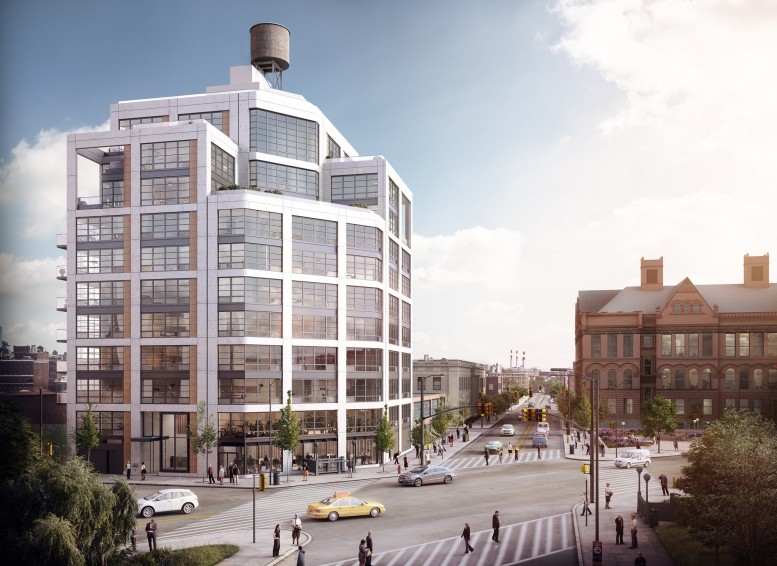In YIMBY’s recent rundown of Long Island City development, we tallied seventeen structures of eight stories and above that have topped-out in the Court Square area within the past twelve months. It appears that The Jackson, which is taking shape at 11-51 47th Avenue, will be the next to join the list. The structure doubled in size between August 15th and the start of October, growing from five to ten floors, so we expect to see the remaining penthouse floor and the service bulkhead rise in the coming weeks. The 53-unit condo project is being developed by Charney Construction and Development, in conjunction with Ascent Development and Tavros Capital, while the industrial-inspired design was crafted by Chris Fogarty of Fogarty Finger.
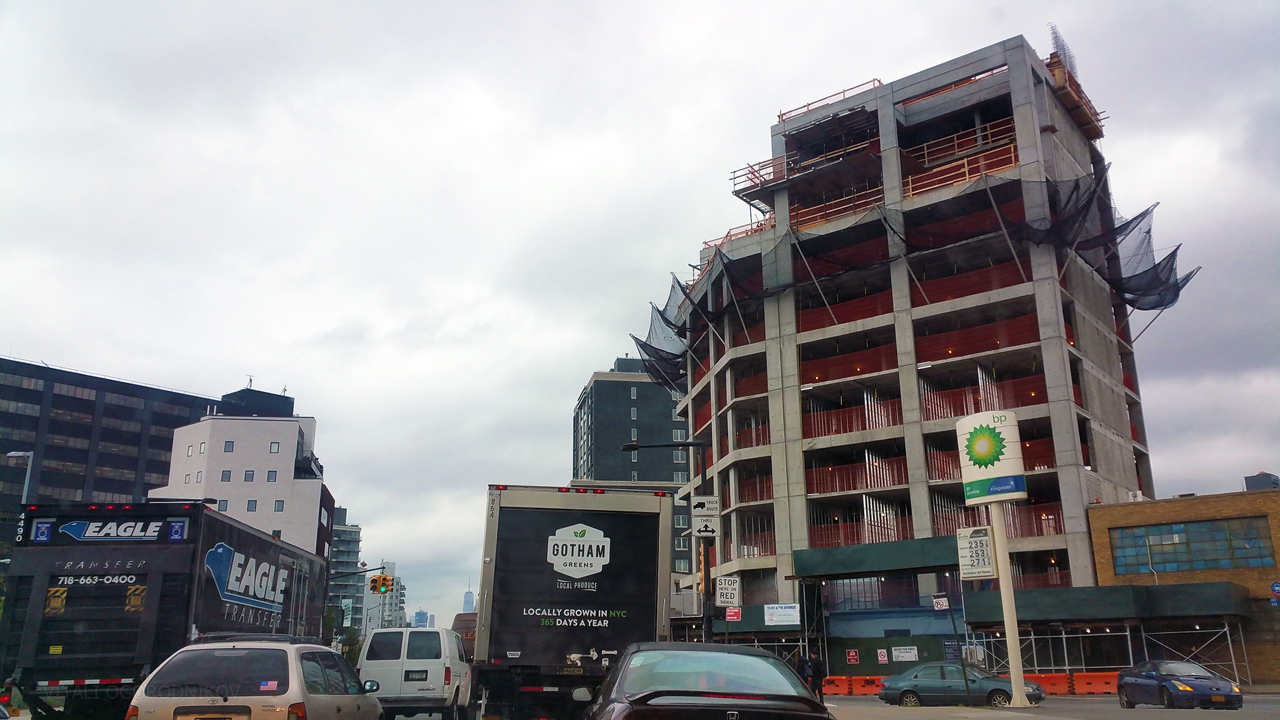
The Jackson at 11-51 47th Avenue (right). Looking southwest along Jackson Avenue. Photos by the author unless indicated otherwise.
According to building permits, the proposed 70,000 square feet of floor space would be mostly occupied by the 52,870-square-foot residential portion. This area would be split between one- to four-bedroom apartments on floors two and above, topped by a penthouse. A 1,244-square-foot retail space would anchor the ground floor, sharing space with a 22-car garage.
Although concrete-frame high-rises are common in Long Island City, most of them conceal the structure behind an applied curtain wall. At The Jackson, the square grid of concrete lintels would remain exposed, framing floor-to-ceiling, loft-like windows, set within black mullions that match black steel lintels running along the floor plates. As a final accent, wood panels would run from base to pinnacle. The building is massed as a roughly square block, chamfered at the corner where the 10,853-square-foot lot meets Jackson Avenue, which gives the project its name. The six-lane avenue is addressed with landscaped decks situated upon setbacks, accessible from the 9th and 11th floors.
The building’s roof would level off at 125 feet, considerably higher than the average 11-story structure, thanks to the tall, loft-like ceilings. The service bulkhead would likely bring the structure within the 150-foot range. Although its skyline impact will be minimal, the building will still stand taller than the rest of the low-rise block to the west (unless another project replaces some of those rowhomes, warehouses, and parking lots).
West-facing balconies and a ninth-floor terrace, set within an exposed cell of the concrete grid, will open towards sweeping vistas of the East River waterfront, located half-a-mile west, and the epic silhouette of Midtown Manhattan beyond. The architect, Chris Fogarty, appears to take particular pride in these features, calling them a “true highlight.”
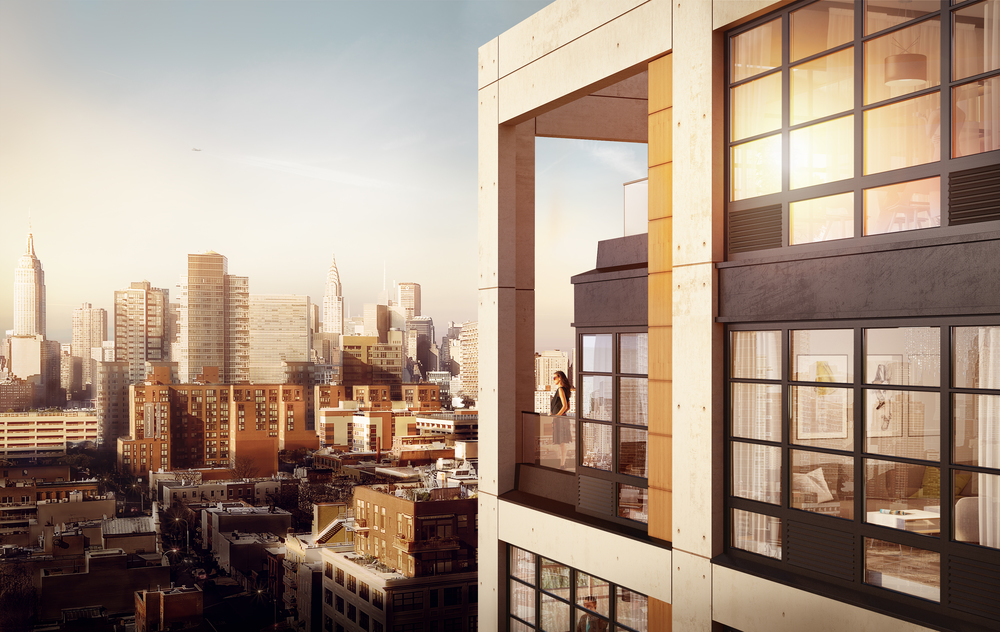
Source: thejacksonlic.com
By contrast, the building’s front façade looks out upon a decidedly less scenic vista, where the six-lane Jackson Avenue, the neighborhood’s main arterial, intersects with 47th Avenue and 21st Street. A massive train depot, part of the Sunnyside Railyard, sits on the other side of the avenue. Jackson Avenue runs southwest for 1,800 feet, where it stops along Long Island City’s industrial southern fringe along Newtown Creek. This heavily-trafficked stretch is lined with a mix of townhouses and recently built residential mid-and high-rises, anchored by a diverse mix of restaurants and nightlife. This corridor forms the backbone for the nascent Hunters Point East neighborhood, named for its location relative to the better-established, high-profile Hunters Point community along the waterfront. In our 2014 interview with the developer, Sam Charney described the neighborhood as the next frontier in Long Island City construction, where “development pressure will come from both sides.”
Moving up the avenue to the northeast, one finds the growing skyscraper district of Court Square, where over 11,000 apartments, over a thousand hotel rooms, and over a million square feet of commercial space are scheduled to rise in the coming years. The blocks to the west and north remained relatively unchanged throughout the development boom, where rowhomes flank quiet, verdant streets. The John F. Murray Playground, Long Island City’s largest green space aside from the waterfront parks, sits just two blocks north.
Lastly, the Jackson also stands across the street from the historic building that contains MoMA PS1, one of Long Island City’s prime architectural and cultural landmarks.
Despite its varied surroundings, the intersection at hand still feels like a no-mans-land, a periphery that lacks a definitive sense of identity. The stretch of Jackson Avenue in front of the building feels like a transient space, not only because of the adjacent railyard, the heavy traffic upon the tree-less avenue, and an adjacent warehouse, but also, in great part, because the composition is anchored by a gas station that sits upon the 8,500-square-foot, triangular lot bounded by Jackson Avenue, 46th Road and 21st Street. Renderings for The Jackson conveniently substitute the gas station with a park, though none is planned at the moment.
We see this as wishful thinking that promotes a much-needed urban intervention. The triangular block has all the ingredients necessary for creating a public space that would become a focal point for the rapidly changing community. It faces the museum to the north, a large, pre-war post office building to the northeast, a major avenue to the southwest, and now The Jackson to the west, adjacent to another potential development site. Just as importantly, the lot sits directly above the 21 Street-Van Alst Station of the G train.
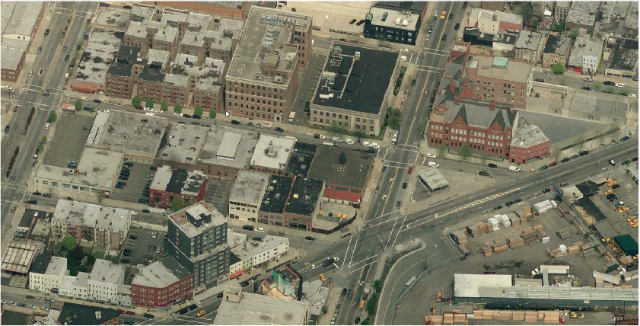
11-51 47th Avenue, prior to construction, at the image center, at the intersection of Jackson Avenue (diagonal) and 21st Street (vertical, center). The suggested plaza site is on the triangular lot (center right), with MoMA PS1 to the north. Credit: Charney Construction
The city is about to invest$38.5 million into revamping pedestrian-unfriendly corners of Long Island City. However, most of these improvements come from eliminating redundant road segments, rather than converting private property into public land.
Still, there are ways to turn the gas station plot into a much-needed public amenity. The most direct path would involve a developer buying the lot, replacing the station with a public plaza (possibly with a city subsidy, or a reward in the form of extra buildable space), and transferring development rights to an adjacent site.
This approach was used to create the Zuccotti Park in Lower Manhattan, which opened up a block-wide green space in the dense neighborhood by transferring the air rights to the adjacent One Liberty Plaza. But while the Downtown project came at the cost of architectural masterpieces such as the Singer and City Investing buildings, the Long Island City project would replace an eyesore gas station. In addition, the plaza may serve as an impetus to increase the subway station’s carrying capacity by re-opening its abandoned entrance.
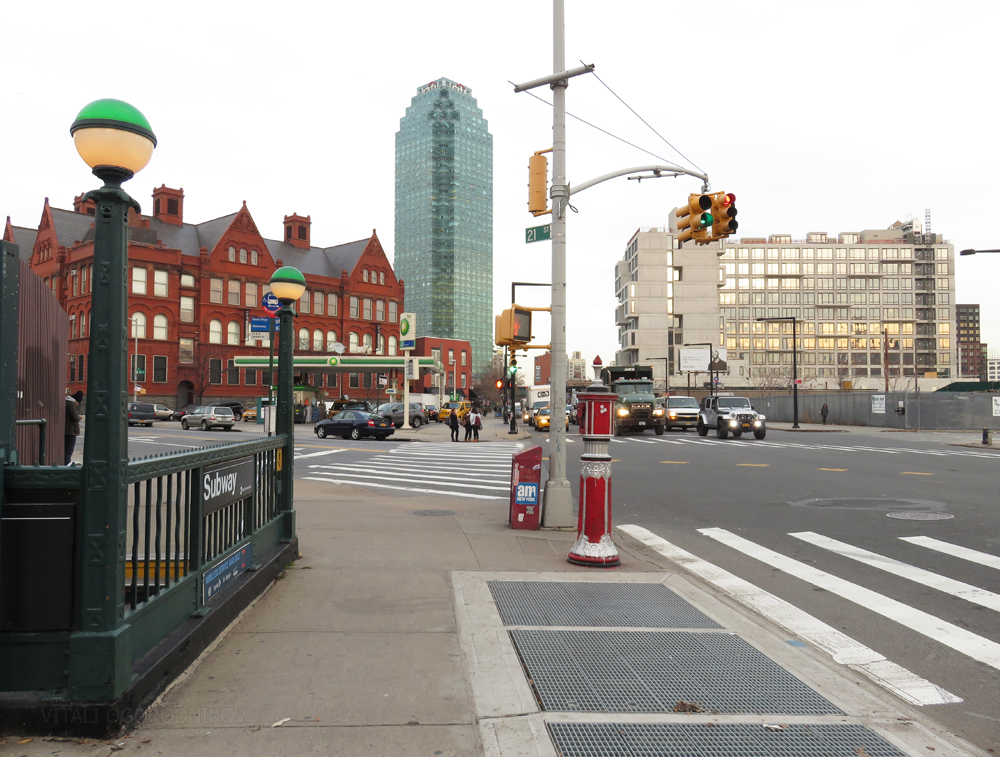
Looking northeast towards MoMA PA1 (left), One Court Square (center), and 5Pointz (behind 22-22 Jackson Avenue, right)
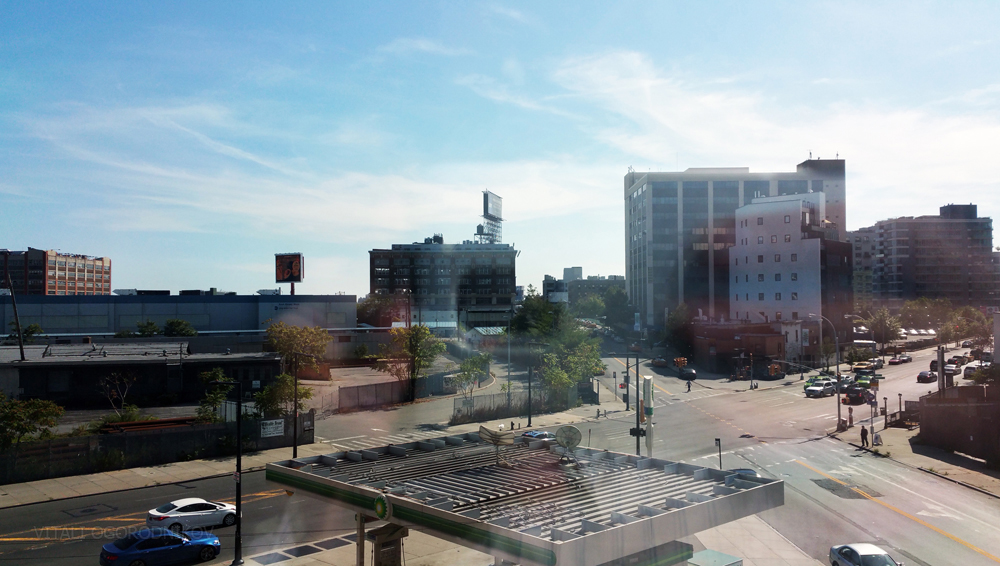
Looking south from MoMA PS1, with the gas station in the foreground, The Jackson site on the right (prior to construction), and the intersection of Jackson and 47th avenues. September 2015.
The new public space might become Van Alst Square, sharing the name with the subway stop, which was named after the Dutch family that settled nearby in 1652. Alternatively, the plaza may bear the name of a local Native American tribe or historical figure. Many of our city’s public spaces are already dedicated to colonial leaders, yet too few honor those that inhabited the land long before the Europeans took over. But regardless of whatever it may be called, the centrally-located, triangular block is a perfect candidate for a new communal gathering space in Long Island City.
Subscribe to the YIMBY newsletter for weekly updates on New York’s top projects
Subscribe to YIMBY’s daily e-mail
Follow YIMBYgram for real-time photo updates
Like YIMBY on Facebook
Follow YIMBY’s Twitter for the latest in YIMBYnews

